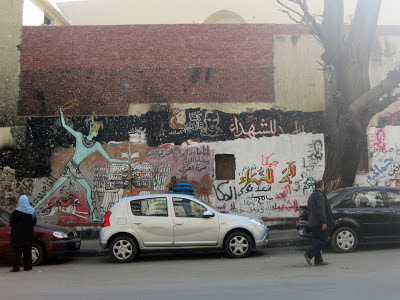(The best way to view these pictures
is to click on one and then watch them as a slide show).
 |
| Tahrir Square. The park is closed to traffic, and people are still camped out to protest the government. |
Folks have asked about my time in Egypt — a part of the world that continues to galvanize graphs on a regular basis. The Middle East has seemingly been colonized as a state of mind by the United States, with no separation between Syria, Bahrain, Yemen, Libya, Lebanon and Egypt — the fear of violence pervades all. If one country is at war, it must mean that surrounding countries are at risk of the same.
 |
| Commemorating the folks who died fighting the revolution. |
Protests and violence and discontent have become the fabric that covers human flesh, and all Egyptian culture, like wool washed in hot water and dried, shrinks to a tight fist — no traveling through a wide weave, now a mere representation of what is.
 |
| Tahrir Square. |
How can I explain that threads of language
are simply pieces of an entire fabric, they are hanging chads that need mending?
Meanwhile, children in Egypt go to school; people work there, shop, cook, pray,
laugh, sing, play, walk, travel, plan, pursue careers, marry, die, make art and
play music. They read the newspaper, listen to the radio and Internet, and
receive tweets the same way we do. Egyptians are downloading news about their own
country as you read this. One or a hundred are wounded; hundreds more show up
for a funeral. Our media represents an entire country and beyond, 83 million
people living in an area about two inches in diameter on the map.
 I discovered on my initial flight to Cairo that I knew relatively
little about Egypt, having based my knowledge upon the news analysis in the
United States along with a bit of history. Turns out that few Egyptians voted
in their newfound democracy, and are passionately against allowing their
beautiful (yet crumbling) country to be defined by a fundamentalist right-wing
power-hungry regime.
I discovered on my initial flight to Cairo that I knew relatively
little about Egypt, having based my knowledge upon the news analysis in the
United States along with a bit of history. Turns out that few Egyptians voted
in their newfound democracy, and are passionately against allowing their
beautiful (yet crumbling) country to be defined by a fundamentalist right-wing
power-hungry regime. 
They are angry that the revolution was “hijacked” by the
Muslim Brotherhood, and are suffering the consequences of change within a
collapsed economy, mostly due to a sharp decline in tourism. Of course, the dismal
economic situation was part of what prompted the revolution in the first place.
 My youngest daughter was scheduled to travel with a 5-person
U.S. teen delegation to an International Peace Camp on the Red Sea this summer,
about 5 hours drive southeast of Cairo. The theme of the camp is Human Rights,
and will be attended by 15-yr-olds from 10 different countries, an
incredible opportunity to halt fear in the minds of these teenagers in hopes of
seeding friendship among young nation-building representatives. Unfortunately,
fear continues to define that distant land for an older generation and
determines its fate. A parent of one child, when I asked her if she was worried
about a fuel shortage in Egypt, said: “My concern is nowhere near that there
will be a shortage of aviation fuel. My concern is that the airport will be
shut down because of civil unrest…It will be the mob that will shut it down
either by barricading it, or there will be fighting nearby so that the airport
will have to shut down.”
My youngest daughter was scheduled to travel with a 5-person
U.S. teen delegation to an International Peace Camp on the Red Sea this summer,
about 5 hours drive southeast of Cairo. The theme of the camp is Human Rights,
and will be attended by 15-yr-olds from 10 different countries, an
incredible opportunity to halt fear in the minds of these teenagers in hopes of
seeding friendship among young nation-building representatives. Unfortunately,
fear continues to define that distant land for an older generation and
determines its fate. A parent of one child, when I asked her if she was worried
about a fuel shortage in Egypt, said: “My concern is nowhere near that there
will be a shortage of aviation fuel. My concern is that the airport will be
shut down because of civil unrest…It will be the mob that will shut it down
either by barricading it, or there will be fighting nearby so that the airport
will have to shut down.” |
| Camp at Tahrir Square. |
My fear is not that an angry mob of Arabs would shut down the airport, but a wayward American drone, in its blind search for terrorists, would find its way to the camp and snuff out the small but valiant effort to overcome fear of the Other.




































































